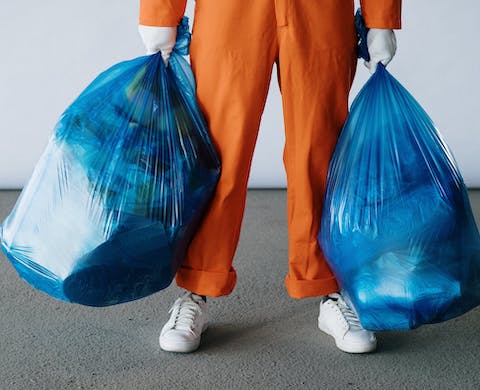The fashion industry’s contribution to clothing waste has become a pressing concern, as highlighted by a viral satellite photo of a mountain of discarded clothes in Chile’s Atacama Desert. While natural fibers like cotton and wool decompose over time, man-made fibers such as polyester and nylon do not. The Biomimicry Institute, a US-based scientific organization, is working on finding a natural way to decompose waste polyester and nylon using biological materials like enzymes or bacteria. Their project, called Design for Decomposition, aims to break down existing fabrics in a more environmentally friendly way and potentially create new innovative materials.
The term “fast fashion” refers to the rapid production and consumption of cheap clothes. According to the Ellen MacArthur Foundation, only 1% of discarded garments are recycled into new clothes, leading to significant carbon emissions and biodiversity loss. Jean Hegedus, head of sustainability at Lycra, acknowledges the need for change in the textile and apparel industry. Lycra is exploring the use of a renewable material called Qira, made from industrial dent corn, to replace petroleum-based fibers. This switch could reduce the carbon footprint of their products by 44%.
Other companies are also exploring innovative solutions to reduce clothing waste. MycoWorks produces leather-like material from mushroom mycelium, while Faber Futures is researching the use of a soil-dwelling bacteria for textile dyeing. Spinnova turns wood pulp into clothing fabric and aims to manufacture one million tons of fiber annually by 2033 in a carbon-neutral factory. However, for a circular textile loop to work, brands and customers need to actively participate in collecting and recycling old garments.
While efforts are being made to address clothing waste, challenges remain. Takeback schemes offered by fashion retailers are not always effective, with many returned items being destroyed or exported to other countries. To truly tackle clothing waste, a shift in consumer behavior and industry practices is necessary.
Original news source: The hunt for a new way to tackle clothing waste (BBC)
Listen
Slow
Normal
Fast
Group or Classroom Activities
Warm-up Activities:
– News Summary
Instructions: Divide the students into pairs or small groups. Have each group read the article and then summarize it in their own words. Each group will then present their summary to the class, highlighting the key points and main ideas.
– Opinion Poll
Instructions: Divide the students into pairs or small groups. Have each group come up with 3-5 discussion questions related to the article. Each group will then take turns asking their questions and recording the responses of their classmates. Afterward, have a class discussion sharing the different opinions and perspectives.
– Vocabulary Pictionary
Instructions: Select 10-15 key vocabulary words from the article and write them on separate index cards. Divide the students into two teams. One student from each team will come to the front of the class and select a card. They must then draw a picture to represent the word on the card, while their team tries to guess the word. The team that guesses correctly earns a point. Repeat with different students and cards until all the vocabulary words have been used.
– Future Predictions
Instructions: Have the students work individually or in pairs. Ask them to brainstorm and write down their predictions for the future of the fashion industry and its impact on clothing waste. Afterward, have a class discussion where students share and discuss their predictions, providing reasons and examples to support their ideas.
– Pros and Cons
Instructions: Divide the students into two groups. Assign one group to list the pros of fast fashion and the other group to list the cons. Each group will then present their list to the class, explaining their reasoning. Afterward, have a class discussion where students can debate and discuss the advantages and disadvantages of fast fashion and its impact on clothing waste.
Comprehension Questions:
1. What are some natural fibers that decompose over time?
2. What is the Biomimicry Institute working on in relation to clothing waste?
3. What is the term “fast fashion” referring to?
4. How much of discarded garments are recycled into new clothes, according to the Ellen MacArthur Foundation?
5. What is Qira and how could it reduce the carbon footprint of products?
6. What are some innovative solutions being explored to reduce clothing waste?
7. What is one challenge in addressing clothing waste mentioned in the article?
8. What is necessary for a circular textile loop to work?
Go to answers ⇩
Listen and Fill in the Gaps:
The fashion industry’s contribution to clothing waste has become a pressing concern, as highlighted by a viral satellite (1)______ of a mountain of discarded (2)______ in Chile’s Atacama Desert. While natural fibers like cotton and wool decompose over time, man-made fibers such as polyester and nylon do not. The Biomimicry Institute, a US-based scientific organization, is working on (3)______ a natural way to decompose waste polyester and nylon using biological materials like enzymes or (4)______. Their project, called Design for Decomposition, aims to (5)______ down existing fabrics in a more environmentally friendly way and potentially create new innovative materials.
The term “fast fashion” refers to the rapid (6)______ and consumption of cheap clothes. According to the Ellen MacArthur Foundation, only 1% of discarded garments are recycled into new clothes, leading to (7)______ carbon emissions and (8)______ loss. Jean Hegedus, head of sustainability at Lycra, acknowledges the need for change in the textile and apparel industry. Lycra is exploring the use of a renewable (9)______ (10)______ Qira, made from industrial dent corn, to replace petroleum-based fibers. This switch could reduce the carbon footprint of their products by 44%.
Other companies are also exploring innovative solutions to reduce clothing waste. MycoWorks produces leather-like material from mushroom mycelium, while (11)______ Futures is researching the use of a soil-dwelling bacteria for textile (12)______. Spinnova turns wood pulp into clothing fabric and aims to manufacture one million tons of fiber annually by 2033 in a carbon-neutral factory. However, for a circular textile loop to work, (13)______ and customers need to actively participate in collecting and recycling old garments.
While efforts are being made to address clothing waste, challenges remain. Takeback schemes offered by fashion retailers are not always effective, with many returned (14)______ being destroyed or exported to (15)______ countries. To truly tackle clothing waste, a (16)______ in consumer behavior and industry practices is necessary.
Go to answers ⇩
Discussion Questions:
Students can ask a partner these questions, or discuss them as a group.
1. What is the fashion industry’s contribution to clothing waste?
2. How would you feel if you saw a mountain of discarded clothes in the desert?
3. Do you like the idea of using biological materials like enzymes or bacteria to decompose waste polyester and nylon? Why or why not?
4. What do you think about the term “fast fashion” and its impact on the environment?
5. How would you feel if more companies started using renewable materials like Qira made from corn instead of petroleum-based fibers?
6. What is your opinion on using mushroom mycelium to produce leather-like material?
7. Do you think using a soil-dwelling bacteria for textile dyeing is a good idea? Why or why not?
8. How do you feel about the idea of turning wood pulp into clothing fabric?
9. What do you think about the goal of manufacturing one million tons of fiber annually in a carbon-neutral factory?
10. How do you think brands and customers can actively participate in collecting and recycling old garments?
11. What challenges do you think exist in addressing clothing waste?
12. How effective do you think takeback schemes offered by fashion retailers are in reducing clothing waste?
13. Have you ever participated in a takeback scheme or clothing recycling program? If so, what was your experience like?
14. What changes do you think need to happen in consumer behavior and industry practices to tackle clothing waste?
15. How can individuals make a difference in reducing clothing waste in their own lives?
Individual Activities
Vocabulary Meanings:
Match each word to its meaning.
Words:
1. clothing
2. fibers
3. decompose
4. innovative
5. carbon
6. leather-like
7. dyeing
8. recycling
Meanings:
(a) A greenhouse gas that contributes to climate change
(b) Materials used to make fabrics and textiles
(c) The act of converting waste materials into reusable materials
(d) Resembling or imitating leather in appearance or texture
(e) The industry that produces and sells clothes
(f) The process of adding color to textiles
(g) Break down and decay over time
(h) Introducing new and creative ideas or methods
Go to answers ⇩
Multiple Choice Questions:
1. What is the main concern regarding the fashion industry’s contribution to clothing waste?
(a) Man-made fibers like polyester and nylon do not decompose over time
(b) Natural fibers like cotton and wool decompose too quickly
(c) The fashion industry is producing too many clothes
(d) The fashion industry is not recycling enough clothes
2. What is the Biomimicry Institute working on?
(a) Creating new innovative materials from discarded clothes
(b) Recycling existing fabrics into new clothes
(c) Finding a natural way to decompose waste polyester and nylon
(d) Developing faster production methods for cheap clothes
3. What does the term “fast fashion” refer to?
(a) The slow production and consumption of high-end clothes
(b) The recycling of discarded garments into new clothes
(c) The use of natural fibers in clothing production
(d) The rapid production and consumption of cheap clothes
4. According to the Ellen MacArthur Foundation, what percentage of discarded garments are recycled into new clothes?
(a) 10%
(b) 25%
(c) 50%
(d) 1%
5. What material is Lycra exploring as a replacement for petroleum-based fibers?
(a) Mushroom mycelium
(b) Qira, made from industrial dent corn
(c) Soil-dwelling bacteria
(d) Wood pulp
6. What does MycoWorks produce?
(a) Leather-like material from mushroom mycelium
(b) Clothing fabric from wood pulp
(c) Textile dye from soil-dwelling bacteria
(d) Renewable fibers from industrial dent corn
7. What is Spinnova’s goal for fiber production by 2033?
(a) One hundred thousand tons annually
(b) Ten million tons annually
(c) One million tons annually
(d) One billion tons annually
8. What is necessary for a circular textile loop to work?
(a) Faster production methods for cheap clothes
(b) Active participation from brands and customers in collecting and recycling old garments
(c) Increased use of natural fibers in clothing production
(d) More takeback schemes offered by fashion retailers
Go to answers ⇩
True or False Questions:
1. The term “slow fashion” refers to the rapid production and consumption of cheap clothes.
2. Natural fibers like cotton and wool decompose over time, but man-made fibers like polyester and nylon do not.
3. Companies like Lycra, MycoWorks, Faber Futures, and Spinnova are exploring conventional solutions to reduce clothing waste.
4. Only 1% of discarded garments are recycled into new clothes, according to the Ellen MacArthur Foundation.
5. A viral satellite photo of a mountain of discarded clothes in Chile’s Atacama Desert has drawn attention to the issue.
6. The fashion industry’s contribution to clothing waste is a growing concern.
7. The Biomimicry Institute is working on finding an artificial way to decompose waste polyester and nylon using synthetic materials.
8. The Biomimicry Institute’s project, called Design for Decomposition, aims to break down existing fabrics in a less environmentally friendly way.
Go to answers ⇩
Write a Summary:
Write a summary of this news article in two sentences.
Check your writing now with the best free AI for English writing!
Writing Questions:
Answer the following questions. Write as much as you can for each answer.
Check your answers with our free English writing assistant!
1. What is the goal of the Biomimicry Institute’s project, Design for Decomposition?
2. What is the term “fast fashion” and why is it a concern?
3. How is Lycra exploring the use of renewable materials to reduce their carbon footprint?
4. What are some innovative solutions being explored by other companies to reduce clothing waste?
5. What are the challenges that need to be addressed in order to effectively tackle clothing waste?
Answers
Comprehension Question Answers:
1. Some natural fibers that decompose over time are cotton and wool.
2. The Biomimicry Institute is working on finding a natural way to decompose waste polyester and nylon using biological materials like enzymes or bacteria.
3. The term “fast fashion” refers to the rapid production and consumption of cheap clothes.
4. According to the Ellen MacArthur Foundation, only 1% of discarded garments are recycled into new clothes.
5. Qira is a renewable material made from industrial dent corn. It could reduce the carbon footprint of products by 44%.
6. Some innovative solutions being explored to reduce clothing waste include producing leather-like material from mushroom mycelium, researching the use of bacteria for textile dyeing, and turning wood pulp into clothing fabric.
7. One challenge in addressing clothing waste mentioned in the article is that takeback schemes offered by fashion retailers are not always effective, with many returned items being destroyed or exported to other countries.
8. For a circular textile loop to work, brands and customers need to actively participate in collecting and recycling old garments.
Go back to questions ⇧
Listen and Fill in the Gaps Answers:
(1) photo
(2) clothes
(3) finding
(4) bacteria
(5) break
(6) production
(7) significant
(8) biodiversity
(9) material
(10) called
(11) Faber
(12) dyeing
(13) brands
(14) items
(15) other
(16) shift
Go back to questions ⇧
Vocabulary Meanings Answers:
1. clothing
Answer: (e) The industry that produces and sells clothes
2. fibers
Answer: (b) Materials used to make fabrics and textiles
3. decompose
Answer: (g) Break down and decay over time
4. innovative
Answer: (h) Introducing new and creative ideas or methods
5. carbon
Answer: (a) A greenhouse gas that contributes to climate change
6. leather-like
Answer: (d) Resembling or imitating leather in appearance or texture
7. dyeing
Answer: (f) The process of adding color to textiles
8. recycling
Answer: (c) The act of converting waste materials into reusable materials
Go back to questions ⇧
Multiple Choice Answers:
1. What is the main concern regarding the fashion industry’s contribution to clothing waste?
Answer: (a) Man-made fibers like polyester and nylon do not decompose over time
2. What is the Biomimicry Institute working on?
Answer: (c) Finding a natural way to decompose waste polyester and nylon
3. What does the term “fast fashion” refer to?
Answer: (d) The rapid production and consumption of cheap clothes
4. According to the Ellen MacArthur Foundation, what percentage of discarded garments are recycled into new clothes?
Answer: (d) 1%
5. What material is Lycra exploring as a replacement for petroleum-based fibers?
Answer: (b) Qira, made from industrial dent corn
6. What does MycoWorks produce?
Answer: (a) Leather-like material from mushroom mycelium
7. What is Spinnova’s goal for fiber production by 2033?
Answer: (c) One million tons annually
8. What is necessary for a circular textile loop to work?
Answer: (b) Active participation from brands and customers in collecting and recycling old garments
Go back to questions ⇧
True or False Answers:
1. The term “slow fashion” refers to the rapid production and consumption of cheap clothes. (Answer: False)
2. Natural fibers like cotton and wool decompose over time, but man-made fibers like polyester and nylon do not. (Answer: True)
3. Companies like Lycra, MycoWorks, Faber Futures, and Spinnova are exploring conventional solutions to reduce clothing waste. (Answer: False)
4. Only 1% of discarded garments are recycled into new clothes, according to the Ellen MacArthur Foundation. (Answer: True)
5. A viral satellite photo of a mountain of discarded clothes in Chile’s Atacama Desert has drawn attention to the issue. (Answer: True)
6. The fashion industry’s contribution to clothing waste is a growing concern. (Answer: True)
7. The Biomimicry Institute is working on finding an artificial way to decompose waste polyester and nylon using synthetic materials. (Answer: False)
8. The Biomimicry Institute’s project, called Design for Decomposition, aims to break down existing fabrics in a less environmentally friendly way. (Answer: False)
Go back to questions ⇧













